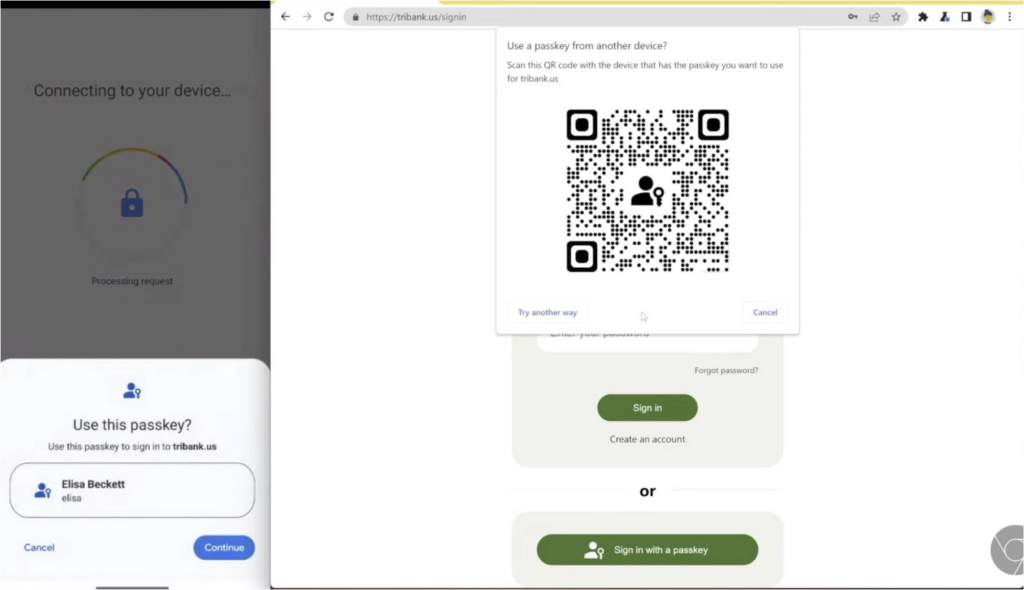Passkey
passˌkee noun
A passkey is a FIDO authentication credential based on FIDO standards, that allows a user to sign in to apps and websites with the same process that they use to unlock their device (biometrics, PIN, or pattern). Passkeys are FIDO cryptographic credentials that are tied to a user’s account on a website or application. With passkeys, users no longer need to enter usernames and passwords or additional factors. Instead, a user approves a sign-in with the same process they use to unlock their device (for example, biometrics, PIN, pattern).
The word passkey is a common noun; think of it the way you would refer to password. It should be written in lowercase except when beginning a sentence or used in a title. The term passkey (and plural form passkeys) is a cross-platform general-use term, not a feature tied to any specific platform.
Created for Security

According to Verizon’s 2024 Data Breach Investigations Report, the overall reporting rate of phishing has been growing over the past few years. Credential breaches and exploitation of vulnerabilities are also growing security concerns.
Passkeys are phishing resistant and secure by design. They inherently help reduce attacks from cybercriminals such as phishing, credential stuffing, and other remote attacks. With passkeys there are no passwords to steal and there is no sign-in data that can be used to perpetuate attacks.
The passkey approach provides an improved security model over traditional authentication and multi-factor authentication. Even better, passkeys are also easier for people to use and result in 20% more successful sign-ins over passwords. For more information, refer to Passkey Security.
Easy and Fast Sign-ins

FIDO authentication is easy to use. People and organizations are rapidly adopting passkeys. In a recent independent survey commissioned by the FIDO Alliance, 53% of people reported enabling passkeys on at least one of their accounts, with 22% enabling them on every account they possibly can.
Benefits of Passkeys
Organizations who implement support for passkeys see the following benefits as passkey use increases:

Improvements for the end user experience
- Higher sign-in success rates
- Faster time to sign in
- Safer, more secure, and faster online experiences
- Cross-device and ecosystem availability

Business improvements
- Higher sign-in success rate, higher conversions, repeat purchases, and less downtime
- Reductions in phishing, credential stuffing, and attack surface
- Lower rate of cart abandonment
- Reduction in need for password resets during account recovery
- Decrease in need for customer support
- Increase in customer loyalty and retention

Lower costs associated with:
- service costs for authentication methods such as SMS text messages
- monitoring and defending malicious actors in real-time
- continuous hardening of traditional authentication solutions
- account reset due to forgot password and account lockout
From these examples, you can see that passkeys benefit both your organization and your end users.
You can view the latest user adoption trends https://fidoalliance.org/content/research/
Get Started with Passkeys
FIDO offers multiple resources related to passkeys. Here are some places to start as you explore passkeys and to help when you’re ready to implement support for passkeys.
- Passkey Central – A public resource for stakeholders seeking to learn more about how to use passkeys.
- Use Cases – Reference to learn about the various passkey use cases.
- Design Guidelines – Design Guidelines that center around design patterns for consumer use cases of passkeys.
- Passkey Directory – Learn how businesses and organizations have leveraged FIDO standards to create password-less authentication to provide secure logins for their employees and clients.
- Get the Passkey Icon – The passkey icon indicates to users that they can securely and easily sign in to their website or app without passwords.
- Passkeys Explainer Video – Watch the 2024 passkeys explainer video to help you get started with passkeys.
Visit passkeycentral.org Today
Passkeys FAQ
Passkeys are a replacement for passwords.
A password is something that can be remembered and typed, and a passkey is a secret stored on one’s devices, unlocked by the user the same way they unlock their device (biometrics, PIN, pattern, etc.).
Unlike passwords, passkeys are resistant to phishing, are always strong, and are designed so that there are no shared secrets.
Passkeys simplify account registration for apps and websites, are easy to use, work across all of a user’s devices, and even other devices within physical proximity.
From a technical standpoint, passkeys are FIDO credentials for passwordless authentication. Passkeys replace passwords with cryptographic key pairs for phishing-resistant sign-in security and an improved user experience. The cryptographic keys are used from end-user devices (computers, phones, or security keys) for user authentication. Passkeys can be securely synced across a user’s devices, or bound to a particular device (device-bound passkeys).
When a user is asked to sign in to an app or website, the user approves the sign-in with the same biometric or PIN or on-device password that the user has to unlock their device (phone, computer, or security key). The app or website can use this mechanism instead of the traditional username and password.
The same standards, commonly known as FIDO2 (WebAuthn and CTAP), are leveraged to deploy FIDO with passkeys for sign-in. The WebAuthn standard covers the browser API that manages passkeys.
The word “passkey” is a common noun; think of it the way you would refer to “password”. It should be written in lowercase except when beginning a sentence.
The term “passkey” (and plural form “passkeys”) is a cross-platform general-use term, not a feature tied to any specific platform.
When delineation is required, passkeys that are synced between user’s devices via a cloud service are generally referred to as “synced passkeys”, and those that never leave a single device (including those on UAF apps) are referred to as “device-bound passkeys.”
Yes. There is no change to the local biometric processing that the user devices (mobile phones, computers, security keys) do today. Biometric information and processing continues to stay on the device and is never sent to any remote server — the server only sees an assurance that the biometric check was successful.
The primary use case for passkeys is replacing the password as the first/primary factor for account authentication. Since passkeys are phishing-resistant and easy to use, they also can replace legacy multi-factor authentication flows, such as password plus SMS OTP. There are other use cases for passkeys, such as in online payment scenarios, within identity wallets, and for automotive, to name a few.
For years, passwords have been subject to phishing attacks and credential stuffing attacks, due to the prevalence of password reuse and database breaches.
Because the primary factor — the password — is fundamentally broken in multiple ways, the industry has seen widespread adoption of layering on an additional second factor. But unfortunately the most popular forms of second factors — such as one time passwords (OTPs) and phone approvals — are both inconvenient and still phishable.
Passkeys are a primary factor that — standing alone — are more secure than the combination of either “password + OTP” or “password + phone approval”.
A passkey provider is responsible for the creation and management of a user’s passkeys. A passkey provider can be a browser or operating system vendor where passkeys are stored and synced within the built in credential manager (such as iCloud keychain or Google password manager), or a third party provider where passkeys are stored and synced within a third party app or browser extension (such as 1Password or Dashlane).
Yes. Passkey syncing is end-to-end encrypted, and passkey providers have strong account security protections.
Syncing is critically important for the FIDO Alliance to achieve its mission, which is to make sign-in easier and fundamentally safer by replacing passwords in as many places as possible.
This is because replacing passwords means “competing” with passwords across three dimensions:
- Speed: should be faster than creating or using a password.
- Convenience: should be at least equally as convenient — if not more convenient — than using a password.
- Security: should be phishing-resistant, and should be guaranteed to be unique per app/website/service.
Speed
The creation of passkeys eliminates the need for users to comply with password complexity requirements. Registration is as simple as a biometric auth or entering a PIN code, and subsequent sign-in attempts with a passkey again only require a biometric authentication or PIN code — both faster than typing in a password.
Convenience
The usability of a password replacement must compete with the convenience of passwords, and one of the primary usability benefits of passwords is that they can be used from any device.
Syncing means that passkeys are available from all of a user’s devices using the same passkey provider. And just like passwords, visiting a website from another device does not require going through a credential registration/creation flow — cross-device sign-in is supported via an enhancement to the FIDO Alliance Client to Authenticator Protocol (CTAP) that uses Bluetooth Low Energy (BLE) to verify physical proximity.
If the cryptographic key is bound to the user’s computer or mobile device, then every time the user gets a new device, the RP would have to fall back to other methods of authentication (typically a knowledge-based credential such as a password). In practice, this often means that the first sign-in on a new device will be inconvenient and phishable.
Passkeys solve this issue because they are available on the user’s device if and when the user needs them — starting from the very first sign-in to a website from that device. Lastly, users often forget passwords and don’t set up backup emails and phone numbers. With passkeys, as long as the user has their device, they can sign in; there is nothing to forget. Because passkeys can be backed up, they can be better protected from loss.
Security
Passkeys, which are FIDO credentials, allow relying parties (which face a constant threat of phishing, credential stuffing, password database breaches, etc.) to replace passwords with FIDO credentials. FIDO offers relying parties a challenge-response authentication protocol based on asymmetric cryptography. This means phishing-resistance, and the elimination of sensitive secrets on the server, resulting in a huge step forward in security.
Phishing resistance is a core design goal of FIDO Authentication. This goal is achieved at sign-in whether or not the cryptographic keys are bound to hardware. Furthermore, breaches of password databases (which can be an attractive target for hackers) no longer pose a threat as there are no passwords to steal.
RPs use the built-in WebAuthn API (for websites) and platform FIDO APIs (for apps) to exercise passkeys for sign-in.
Passkeys are supported in all major operating systems, internet browsers, and by third-party passkey providers.
When a user creates a passkey on any of their devices, it gets synced to all the user’s other devices using the same passkey provider that is also signed into the same user’s account. Thus, passkeys created on one device become available on all devices.
Notably, if the user gets a new device and sets it up with their passkey provider, the user’s passkeys are synced and available for sign-in on the new device.
FIDO has defined cross-device authentication for this use case. Cross device authentication allows a user to sign in with their device using a QR code.
FIDO Cross-Device Authentication (CDA) allows a passkey from one device to be used to sign in on another device. For example, your phone can be linked to your laptop, allowing you to use a passkey from your phone to sign into a service on your laptop.
CDA is powered by the FIDO Client-to-Authenticator Protocol (CTAP) using “hybrid” transport. CTAP is implemented by authenticators and client platforms, not Relying Parties.

The FIDO Cross-Device Authentication flow, which leverages CTAP 2.2, uses Bluetooth Low Energy (BLE) to verify physical proximity, but does not depend on Bluetooth security properties for the actual security of the sign-in. The CTAP transport, named ‘hybrid’, uses an additional layer of standard cryptographic techniques — on top of standard Bluetooth security properties — to protect data.
Passkeys leverage multiple factors for authentication: the passkeys are kept on a user’s devices (something the user “has”) and — if the RP requests User Verification — can only be exercised by the user with a biometric or PIN (something the user “is” or ”knows”).
RPs may be concerned that a passkey could be made available to an attacker through a single factor (say, a password) from the passkey provider account. In practice, however, this is not usually the case: passkey providers consider multiple signals beyond the user’s password — some visible to the user, some not — when authenticating users and restoring passkeys to their devices.
Note that some regulatory regimes still have to evolve to recognize passkeys as one of the officially listed forms of multi-factor. This is an area of active engagement for the FIDO Alliance.
If a user utilizes a cross-platform passkey provider like Google Password Manager or Bitwarden, configuring the provider on their new device will make their passkeys available on that device.
If the user stores their passkeys on a FIDO Security Key, they can use it to securely authenticate on the new device.
If the user is not using a cross-platform passkey provider and is still in possession of their old device, the user can use the passkey on the old device (say, an iOS device) to sign the user into their account on the new device (say, an Android device). Once signed in, the user can create a passkey in the new device’s provider.
In other cases, the RP can treat sign-in from the new device (which might be from a different vendor) as a normal account recovery situation and take appropriate steps to get the user signed in.
Yes, FIDO Security Keys today can house device-bound passkeys and have done so since 2019, when FIDO2 added support for passwordless sign-ins via discoverable credentials with user verification. All the client platforms and browsers have native support to exercise security keys already. Security key vendors may choose to support passkey synchronization in the future.
Since all passkeys are FIDO credentials, a web service implementing support for FIDO will be able to support all passkey implementations.
Specific environments with particular compliance needs may be required to guarantee there is only one copy of the cryptographic key available. Passkeys on FIDO Security Keys are a great solution for such use cases.
Also, in scenarios where a user has lost access to all of their other mobile and other devices where their passkeys have been synced, such FIDO security keys can act as a recovery credential.

